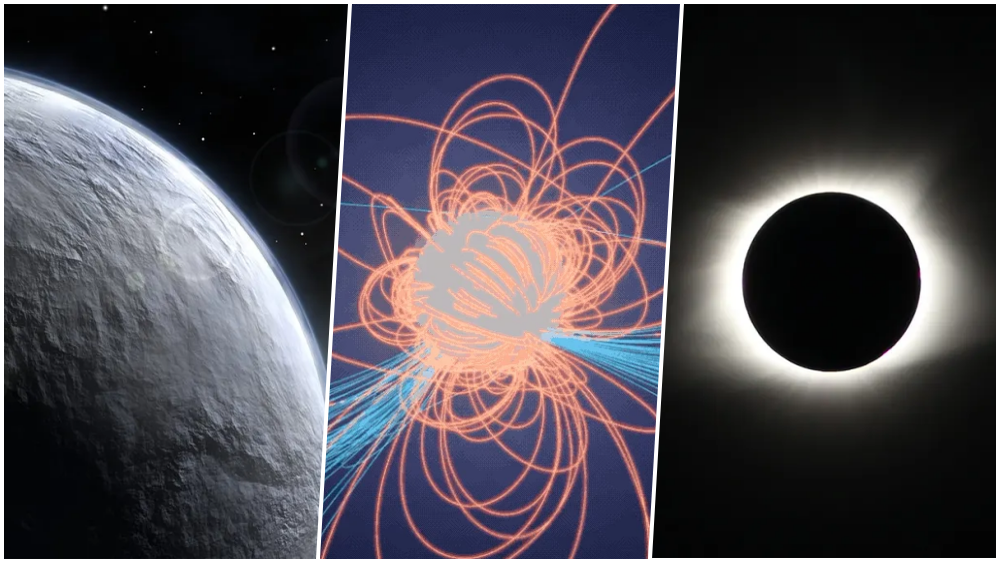The sky is not the limit! | Planet in shadows, gravitational waves, eclipses e+
4 min read
The last week of the month was exciting for astronomers, because a great discovery was announced: a signal from gravitational waves in the cosmic background, which will help find the most catastrophic events in the young universe. In addition, NASA has selected surveys to be conducted in the next total solar eclipse.
Check out below from the week’s news about the space that’s gotten the most attention.
The icy planet is hidden from the sun
This is not a concrete discovery, but a group of researchers has published a study showing that there may be a giant icy planet in the Oort cloud, the final frontier of the solar system inhabited by countless chunks of ice. It is so far from the Sun that it is impossible to notice it.
The suggestion is that giant planets, such as Jupiter and Saturn, could be born in pairs, as if they were twins, but one would end up being expelled by a gravitational “kick” from its brother. Since the Oort Cloud is spherical (not a disk, as it is in the inner solar system), no matter which direction the planet took, it would end up catching the ball.
background gravitational waves
Scientists have finally found something they’ve suspected existed for years: an ocean of gravitational waves throughout the universe, distributed in all directions and shaped since the beginning of time. They call these “background gravitational waves of the universe” because they are behind all the other, younger wave signals.
Just as the cosmic microwave background is light left over from the Big Bang, emitted before all other light in the universe, so gravitational background waves may have been triggered by the universe’s first cataclysmic events, such as collisions between giant black holes. Astronomers hope that by analyzing these signals, they can learn how supermassive black holes evolved so quickly in the universe.
Studies during the next total solar eclipse
In 2024, there will be a total solar eclipse. Unfortunately, the phenomenon will not be visible in Brazil, but it will provide a rare opportunity to observe the sun’s corona from Earth. Therefore, NASA has selected five research projects that will take place during the event.
The main focus of the research is trying to find out why the solar corona has a temperature of more than 1 million degrees Celsius. For this purpose, aircraft will fly light-measuring equipment in this region, which is the only one that will be exposed around the lunar shadow. Other studies will attempt to measure how the eclipse interferes with radio transmissions and affects Earth’s ionosphere.
The cloud image formed during spacecraft testing
SpaceX ran a static test with six Starship engines, firing them all for a few seconds. This is an important step since the rocket launch, so it looks like the company is preparing for its next flight test. On its official Twitter account, SpaceX shared a video of the test.
There is still no exact date for the spacecraft’s next flight test, but it will likely happen in a few weeks. On this flight, the system consisting of the Super Heavy propellant prototypes and the Starship, the ship itself, must be launched from Starbase in Texas.
The asteroid is closer to Earth than the Moon
Asteroid 2023 MU2, which “visited” Earth on Sunday (25), was only 215,000 km from our planet, almost half the average distance between Earth and the Moon. Taking advantage of this occasion, the Virtual Telescope project made images that track the object’s trajectory.
Although the asteroid came very close, it posed no danger. However, it is important for astronomers to monitor the behavior of these objects, and to update orbit calculations so that none of them surprise us.
mission to live for a year on Mars
NASA has placed four people to live in a space that simulates conditions on Mars and a shelter similar to what would be used on a real mission to the planet. They will live there for a year to see some of the challenges that future planetary explorers will have to face on the Red Planet.
Individuals were selected through a program open in 2021 to people who meet the same criteria as NASA astronaut candidates. They will reside in an environment of 160 square meters where they will perform various activities, such as growing crops, spacewalks imitating the gravity of Mars, and scientific experiments.
The mystery of the “missing” stars in the Milky Way
At the center of our galaxy, near the supermassive black hole Sagittarius A*, is a cluster of stars known as the SSC, formed from “S stars”. They are used to measure the properties of a black hole, but there is a “hole” in there that stars have to fill.
There is no physical mechanism to explain why stars do not penetrate into this region, which is called the avoidance zone. A new study has been published that takes some of the hypotheses already proposed to solve the mystery and discards some.
The authors argue that the area may appear empty simply because there was not enough time to observe. If so, you will have to wait for the stars orbiting the area to appear again, which can take a long time.
The sunspot that grew very quickly
The sunspot was born in the very young AR3354 active region in a region of strong magnetic activity, around 7:26 PM on Monday (26). In just 24 hours, it became the size of the five planets. Below, you can see a time snapshot of the macula growth.

This same region caused a moderate-intensity solar flare on Thursday (29), but there was no coronal mass ejection. The spot makes its way across the surface of the Sun and is currently the only large spot on the visible side of our star.

“Entrepreneur. Music enthusiast. Lifelong communicator. General coffee aficionado. Internet scholar.”

:strip_icc()/s04.video.glbimg.com/x720/11792055.jpg)

:strip_icc()/s03.video.glbimg.com/x720/11786998.jpg)



